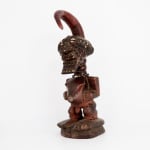Songye Nkisi Power Figure, Nineteenth to Twentieth Century AD
Wood, Brass, Iron, Shell, Stone, Glass, Fibre
46.8 x 14.5 x 16 cm
18 3/8 x 5 3/4 x 6 1/4 in
18 3/8 x 5 3/4 x 6 1/4 in
CC.48
Further images
-
(View a larger image of thumbnail 1
)

-
(View a larger image of thumbnail 2
)

-
(View a larger image of thumbnail 3
)

-
(View a larger image of thumbnail 4
)

-
(View a larger image of thumbnail 5
)

-
(View a larger image of thumbnail 6
)

-
(View a larger image of thumbnail 7
)

-
(View a larger image of thumbnail 8
)

-
(View a larger image of thumbnail 9
)

-
(View a larger image of thumbnail 10
)

-
(View a larger image of thumbnail 11
)

The nkisi (plural minkisi) power figures of the Congo are a phenomenon that traverses across tribal boundaries. In these small tribal societies, where community cohesion was paramount, such figures became...
The nkisi (plural minkisi) power figures of the Congo are a phenomenon that traverses across tribal boundaries. In these small tribal societies, where community cohesion was paramount, such figures became important in healing, cursing, and hunting out witchcraft. Minkisi are magically imbued objects, which became active participants in the community. The community’s magic practitioner (nganga) uses minkisi to defend the living against black magic, and to provide healing to maladies brought about by witchcraft or the intervention of spirits (bakisi).
This nkisi has been richly decorated, demonstrating the importance of this figure to the life of the community. His head, body and legs occupy fully equal parts of the figure. His head is bulbous and rounded at the top of the cranium, with small eyes of inlaid shell, a large triangular nose plated in iron, and thick full lips protruding a full centimetre from the face. The figure has a square chin, and wears a headdress consisting of a large horn-like element that curves from the top of the scalp. His face is covered in brass nails The neck is made of three rounded elements, and sports a necklace with stone and blue glass beads. He has square shoulders, with arms reaching down to his distended abdomen, which contains the cavity for the bilongo. His legs are short and stocky, with a small circumcised penis; his feet are disproportionately large and flat.
The creation of the nkisi was a collaborative effort. First, a sculptor created the overall shape of the figure, leaving a concavity in the navel. The a nganga would fill the cavity with grave dirt, blood, or other magically potent organic material (bilongo). The cavity was then sealed, thereby imbuing the figure with the power of the spirits. As a central focus for the community in times of hardship, the nkisi became an important locus of social cohesion for the Songye. They were also important for communicating between the living and the dead, and between the physical and spirit worlds. Through minkisi, the ancestors and the bush spirits remained central actors in Songye society.
This nkisi has been richly decorated, demonstrating the importance of this figure to the life of the community. His head, body and legs occupy fully equal parts of the figure. His head is bulbous and rounded at the top of the cranium, with small eyes of inlaid shell, a large triangular nose plated in iron, and thick full lips protruding a full centimetre from the face. The figure has a square chin, and wears a headdress consisting of a large horn-like element that curves from the top of the scalp. His face is covered in brass nails The neck is made of three rounded elements, and sports a necklace with stone and blue glass beads. He has square shoulders, with arms reaching down to his distended abdomen, which contains the cavity for the bilongo. His legs are short and stocky, with a small circumcised penis; his feet are disproportionately large and flat.
The creation of the nkisi was a collaborative effort. First, a sculptor created the overall shape of the figure, leaving a concavity in the navel. The a nganga would fill the cavity with grave dirt, blood, or other magically potent organic material (bilongo). The cavity was then sealed, thereby imbuing the figure with the power of the spirits. As a central focus for the community in times of hardship, the nkisi became an important locus of social cohesion for the Songye. They were also important for communicating between the living and the dead, and between the physical and spirit worlds. Through minkisi, the ancestors and the bush spirits remained central actors in Songye society.










